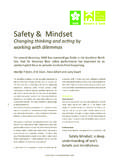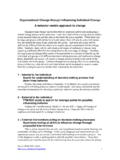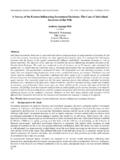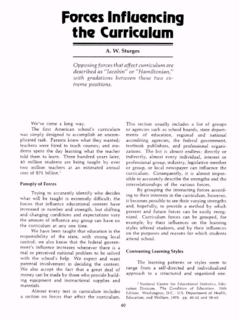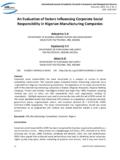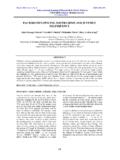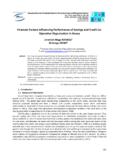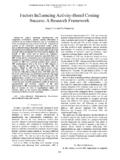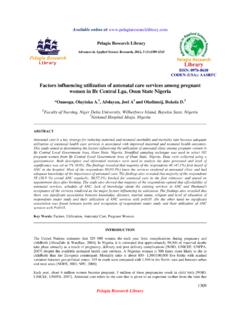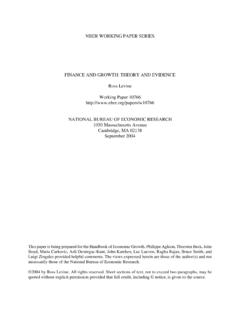Transcription of Managing power: the use of influencing styles - …
1 Managing power : the use of influencing styles Introduction Both in organizations where hierarchy is important and in organizations where emphasis is on collaborative relationships, personal influencing capability matters. It s not only your formal position, the stripes on your sleeve that make the difference. Particularly an executive s own influencing capability and power determine his or her personal effectiveness. In this hand-out we discuss various of influencing so as to elucidate: what influencing styles look like and what the effect of their application is But first we will briefly explain the difference between the exertion of influence and power . The reason for this is we have noticed that the negative ring of power has an inhibiting effect on the way we think about our own influencing capability as well as on means to increase it. power and influencing capability The exertion of power quite frequently gives rise to unpleasant feelings, such as dependence, manipulation, misuse and having to do things one doesn t want to.
2 In many cases, these feelings stem from one s own experience with other people s behavior. All of us have, at some time or other, experienced a situation in which we felt under pressure or belittled by the power exerted by someone else. What we experience then is a feeling of powerlessness, a feeling of being subjected to another person s power , of being belittled. Examples: a policeman who can fine you as he pleases an executive who can thwart a promotion; situations in which someone else has means of power which you do not possess yourself. Someone else ridiculing one of your ideas, which makes you feel that your contribution is not appreciated. However, power can also be used positively, as in the following cases: an executive who tells an employee what he expects in terms of results, and who asks what kind of support the employee needs to achieve that result.
3 A person who listens to another person, and who shows that he is doing so by asking questions, by summarizing and by reflecting the other person s feelings. In these examples the other person is accepted as he is, taken seriously. The person who uses his influence in these examples is perceived as transparant, reliable and as a pleasant discussion partner. In the master class we concentrate on how to exert our personal influencing capability. This personal capability has little to do with one s hierarchical position in the organization, but much more with one s personal skills in the field of exerting influence. Searching for and rediscovering influencing options The influencing styles that are central in this master class will, no doubt, be recognized by most, because we have used them when we where children, or because we have seen other people use them. As a result of the experience we gained in the course of our lives, some of these styles have fallen into disuse while yet other have developed as preferred styles .
4 Experiences such as: parents who teach their children to ask for things in a polite manner, instead if saying I want this or that . a person who frequently uses the same style in a commanding manner, so that the other person will start to dislike it. being submerged, for a prolonged period of time, in a certain culture in which a certain style is invariably appreciated (such as scoring points by arguing) whereas another is not (such as daring to be vulnerable). The object of this master class is to acquire greater skill in using influence and, thus, in switching between styles depending on what is desirable in a certain situation. Energy: pushing and pulling When using influence, energy can be applied in two directions, namely for pushing and pulling. We mean the following by this: moving contrary to another person, or pushing (for instance: I want you to hand this report at tomorrow ) moving along with another person, or pulling (for instance: What is your opinion about this proposition?)
5 When a person is using push energy, he occupies a lot of space; when he uses pull energy, things are exactly the ohter way round. In the latter case he rather allows space to the other person. The trick is to use both types of energy, since a leader is only effective when he displays both pushing and pulling energies. A person who only pushes is perceived as commanding, as focussing on himself instead of the other person. A person who only pulls is perceived as interested, but unclear as to what he wants himself. In addition, it is important to ensure a balance between pushing an pulling; every situation calls for a different balance between push and pull energies. Five influencing styles We distinguish five influencing styles : 1. persuading 2. stating 3. bridging 4. inspiring 5. moving away Persuading and stating use push energy, bridging and inspiring use pull energy and moving away doesn t use either of these.
6 We will discuss each style separately. Re 1 Persuading This style is characterised by making proposals and substantiating these. People who are good at this style will, for instance, table ideas in a meeting; they will support these ideas with facts and arguments, and they do so in a quiet and business-like manner. Elements of this style: Making proposals This includes the tabling of ideas and proposals. I suggest that we select three out of the ten recommendations mentioned in the report, as I feel that these deserve the highest priority . I suggest that we finish the meeting at Arguing By this we mean arguing to underpin one s own proposal or idea, such as: My proposal is that we d better give full attention to three issues than dealing with only parts of all issues. The reason I say so is that it s my experience that this limitation results in the ideas actually being implemented.
7 I suggest we agree on a time to end this meeting, for I know from experience that acting in this way makes it much easier to stick to agreements made . The style of arguing can also be used to provide arguments opposing someone else s proposal, or to express doubt. For example: I do not agree to your proposal to raise our profit by putting a new product on the market, because further development of our current product will save us time, also resulting in profit. Using this style, it is important to briefly and powerfully mention the most important arguments, instead of burying the other person under a load of arguments. Re 2 Stating A person who is skilled in this style does the following: formulating accurately what he expects from the other person. judging, either positively or negatively, about the other person s contribution. offering reward of threatening punishment, with the objective of changing the other person s behaviour.
8 People who effectively (in the right situation and in a clear manner) use this style are transparent, consistent and predictable. Elements of this style: Setting standards By this we mean the formulation of needs, requirements, standards, expectations and feedback (in feedback you use a combination of judgements and setting standards). Example: I don t need your help for this (= need) I d like to have this report at (= requirement) The last three times you were late for our appointment; this makes me feel that you think our appointments are unimportant to you (= judging). I would appreciate it if you could be on time in the future (= setting standards). Judging By this we mean expressing a judgement (either positive or negative) about the other person s behaviour or contribution, on the basis of one s own values or intuition. For example: I think that you have very transparently underpinned the proposal.
9 Bargaining By bargaining about performances or actions you make it attractive for the other person to do something, or to refrain from doing something. If you assist met today in finishing this report, I will help you with the preparations for this new assignment . If you get on with this job now, we can stop earlier this afternoon . Re 3 Bridging A person who uses this style focuses on the other person, is interested in how the other person perceives the situation. This person tries to put himself in the other person s position and radiates interest in the other person. This is done by listening, encouraging the other person and by expressing what he is saying. Elements of this style: Involving By this we mean: asking for information and opinions, supporting and encouraging the other person, reacting to what the other person thinks or feels. For example: What do you think of the idea Peter has suggested?
10 (= asking for an opinion) To me, your feedback is helpful; would you do again next time? (=encouraging the other person) I notice that you feel not responded to in this group; how about trying to find out what causes this? (= reacting to what the other person thinks or feels). Listening This consists of summarising what the other person has said and expressing the other person s feelings. Example: If I understand you correctly, you prefer to postpone our appointment? (= summarising) You are very satisfied with the results so far . (=expressing the other person s feelings) Re 4 Inspiring The person who uses the inspiring style uses energy to induce another person to join or follow him. It is a style which gives meaning and substance to activities and which brings people together on their way to a common objective. A person who is skilled in this style acts as follows: he searches for and stresses common values, interests and ideals in order to achieve adequate co-operation.
